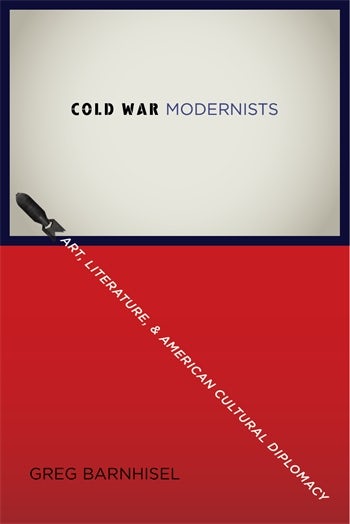HERE IS A LIST of some major players in Cold War Modernists, Greg Barnhisel’s fascinating and meticulously researched history of modernist art and literature’s role in Cold War diplomacy: the American Artists Professional League (AAPL); the American Federation of Arts (AFA); the Committee on Public Information (CPI); the Congress for Cultural Freedom (CCF); the International Information Administration (IIA); the Office of Inter-American Affairs (OIAA); the United States Information Agency (USIA); the United States Information Service (USIS); and the All-Union Society for Cultural Relations with Foreign Nations, which, by way of a complicated transliteration, adopted the acronym VOKS.
Imagine all of the paperwork produced by one of these benignly titled groups: the mission statements and monthly summaries, official memos and interagency notices, budgets and projected spending reports. Then imagine the size of the file cabinet needed to house all of the documents for it and all of the governmental, quasi-governmental, and philanthropic organizations that dealt in foreign policy and cultural diplomacy between the rise of the Iron Curtain and the fall of the Berlin Wall (or, to take the slightly more manageable time frame at the heart of Cold War Modernists, between the Truman and Kennedy administrations). This will give a sense of the archive from which Barnhisel culls his study. And now imagine the time and patience it would require to find, request, and read this material, and make it say something about the fate of modernist literature and art after their initial spark in the 1910s and 1920s.
This is the work accomplished by Cold War Modernists, which makes a convincing case that the real story of American art and literature after World War II is buried in the file folders and meeting minutes of groups with unglamorous names like the Office of War Information and the Office of Facts and Figures. By digging through their archives — not the first resources one might think of when composing a literary history of American modernism — Barnhisel shows how these agencies helped to transform a loose collection of antiestablishment, purposefully difficult artists into a prominent prong of Cold War diplomacy, and in the process turn “modernism” into a style of representation equally at home in IKEA and MoMA. In chapters that detail art exhibitions organized by the USIA; book publishing programs funded by the Department of State; arts journals paid for by the Ford Foundation and, discretely, by the CIA; and the Voice of America radio broadcasts that beamed US-centered programming into dozens of countries, Cold War Modernists admirably captures the wide variety of institutions that, from the late 1940s until the mid-1960s, attempted to woo European and South American intellectuals away from their Soviet sympathies with an interpretation of modernism that emphasized freedom, individualism, and democratic debate — in other words, a modernism that stood for the United States.
